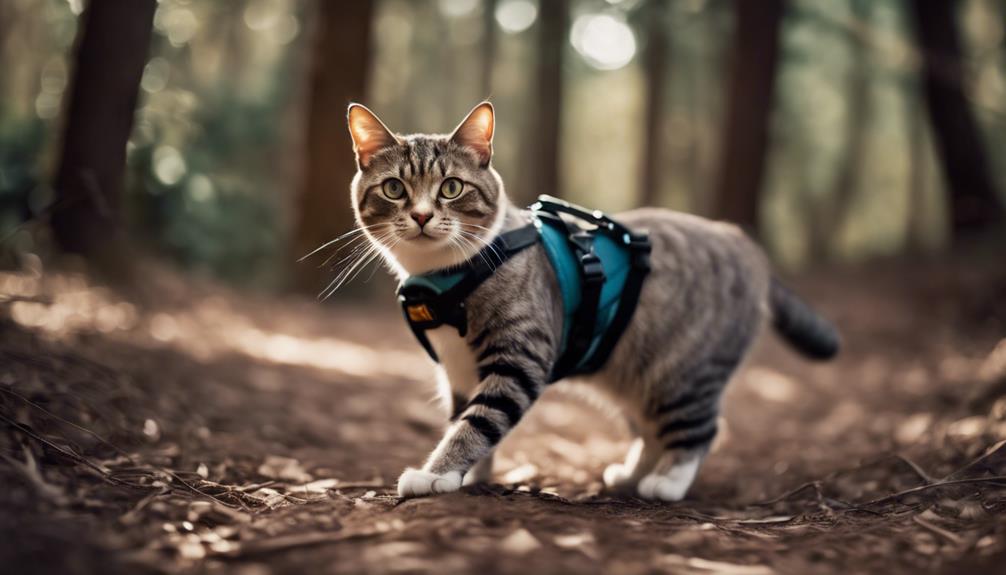When it comes to preparing your feline friend for thrilling outdoor escapades, understanding the fundamentals of adventure cat training is key. From harness training to boundary setting, each step plays a crucial role in shaping your cat into a confident explorer. But what about the more nuanced aspects of adventure cat training? Stay tuned to uncover the finer details that will elevate your cat's outdoor experiences to new heights in 2024.
Harness Training for Adventure Cats
To prepare your adventure cat for outdoor exploration, harness training is an essential step to ensure their safety and enjoyment. Training your indoor cat to wear a harness is the first step towards exciting outdoor adventures.
Begin by introducing the harness indoors in short sessions, allowing your cat to get used to the sensation of wearing it. Use treats and positive reinforcement to make the experience positive for your feline friend. Encouragingly, progress to attaching a leash to the harness for short periods, letting your cat explore with gentle guidance.
As your cat becomes more comfortable with the harness and leash indoors, you can gradually transition to outdoor training. Start in a secure and familiar environment to avoid overwhelming your cat. It's crucial to ensure the harness fits correctly and is snug but not too tight for your cat's comfort and safety.
Cat Backpack Training Techniques
Gradually introduce your cat to the cat backpack at home to familiarize them with this new gear. Use treats and toys to create positive associations with the backpack. Encourage your cat to explore the backpack by placing treats inside and letting them investigate at their own pace. Practice short trips around the house so your cat can get used to the sensation of being in the backpack before going on longer adventures.
Ensure the cat backpack is secure and comfortable for your feline friend. Adjust the straps to fit snugly but not too tight, allowing your cat to move comfortably. Monitor your cat's behavior during training sessions. Look for signs of stress or discomfort, and if needed, take a step back and go slower in the training process. By observing your cat's reactions, you can gauge their readiness to embark on outdoor adventures in the backpack.
Leash and Harness Basics
Introduce your adventurous cat to leash and harness basics to prepare them for safe outdoor excursions.
When it comes to cat harnesses, ensure it fits snugly but allows for movement. Opt for a lightweight leash that's at least 6 feet long to give your cat flexibility.
Start harness training indoors to help your feline friend get used to the gear. Let them explore with the leash on to boost their confidence and familiarity with it.
Use treats and positive reinforcement to encourage your cat to walk beside you on the leash. Remember, patience is key when walking a cat, so take it slow and allow your cat to adjust at their own pace.
With the right adventure cat gear and proper cat training, you'll soon be ready to embark on outdoor escapades together.
Off-Leash Recall Training Tips
Consider incorporating a distinctive recall cue when training your adventure cat for off-leash excursions. Start by practicing off-leash recall training in a controlled indoor environment using high-value rewards to reinforce positive behavior.
Understand the risks involved in off-leash activities for cats and consider microchipping your cat for added safety during outings. It's crucial to supervise your cat closely during off-leash time to ensure their well-being.
Pay close attention to your cat's behavior and surroundings when allowing them off-leash to mitigate any potential risks. By being proactive and attentive, you can help prevent mishaps and keep your adventure cat safe during outdoor excursions.
Remember that consistent training, coupled with supervision and safety measures like microchipping, is key to successful off-leash adventures with your feline companion.
Setting Boundaries for Outdoor Adventures
Establishing clear boundaries during outdoor adventures is essential for ensuring your cat's safety and well-being.
When training your adventure cat, use positive reinforcement to teach them where they can explore and what areas are off-limits.
Consistent rules and boundaries help your cat understand their limits and feel secure in their environment.
It's important to create a safe space within your outdoor setting where your cat can retreat if they feel overwhelmed or need a break.
Adventure Cat Safety Measures
When training your adventure cat, remember to prioritize their safety above all else. Ensuring they're protected from potential health risks with vaccines and flea/tick treatments is crucial.
Equipping them with the right gear and being prepared for emergencies will help keep your furry friend safe during outdoor escapades.
Adventure Cat Safety Tips
To ensure the safety of your adventure cat, prioritize their health and well-being by preparing them with proper vaccinations and flea and tick treatments before outdoor excursions.
When taking your cat outdoors, always use a harness and leash to keep them secure and under control. Pay attention to your cat's body language and movements during their outdoor adventures to ensure they're comfortable and safe.
Limit the time outdoors initially and gradually increase it to allow your cat to adjust. Protect their sensitive toe pads from rough terrain and consider applying protective wax for added safety.
Lastly, have a first aid kit handy in case of emergencies and monitor your cat closely for any signs of distress.
Gear Checklist
For ensuring the safety of your adventure cat, having the right gear is essential. A portable litter box is a must-have for outdoor adventures to maintain hygiene. Make sure to keep your cat on a leash to prevent them from wandering off during outdoor excursions. Using a carrier or backpack provides a safe way to transport your furry friend.
High-quality cat food is essential to keep your cat fueled and energized while spending time outside. Collapsible water and food bowls are convenient for travel, ensuring your cat stays hydrated and well-fed. Don't forget to pack some cat treats to reward good behavior and make the experience enjoyable for both your cat and you, the adventurous cat parents.
Frequently Asked Questions
How Do You Train a Cat to Be an Adventure Cat?
To train a cat to be an adventure cat, start early with positive reinforcement. Introduce a cat backpack gradually at home before outdoor trips. Monitor for stress signs and adjust training. Practice short trips to build comfort.
At What Age Is It Too Late to Train a Cat?
It's never too late to train a cat, but older cats might take longer to learn new behaviors. With patience and consistency, you can still teach them new tricks and adventures, adapting to their age and experiences.
Can All Cats Be Adventure Cats?
Not all cats can be adventure cats. Factors like temperament, health, and breed influence this. Cats with a curious and adaptable nature have a better chance. Respect your cat's preferences and boundaries; not all are natural adventurers.
How to Train a Cat Step by Step?
Introduce your cat to a harness indoors with treats and patience. Attach a leash gradually, encouraging short indoor walks. Move outdoors when ready, observing their comfort. Consistency and positive reinforcement are key throughout the process.






